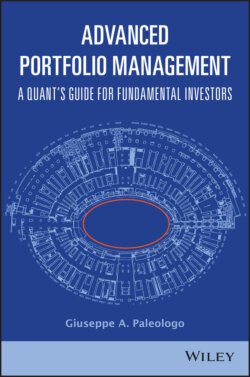Читать книгу Advanced Portfolio Management - Giuseppe A. Paleologo - Страница 16
3.5 First Steps in Risk Decomposition
ОглавлениеThis very simple decomposition already has very powerful implications. Volatility either comes from a systematic source or a stock-specific one. Where does your skill lie? In going long or short the market, or rather in going long or short the company-specific returns? One attractive feature of being long the market is that its risk is accompanied by positive expected returns. The inflation-adjusted annualized historical return of the S&P 500 from 1926 (the inception year of the index) to 2018 is 7%; so it may seem a good idea to have a positive beta to the market. Indeed, a sizable fraction of the global assets under management are actively managed funds that track an index. This means that the portfolio has a positive percentage beta, often equal to 1, and a certain budget of volatility allowed to run in idiosyncratic PnL, sometimes called the tracking error. For example, our previous portfolio in Table 3.5 has a tracking dollar vol of $1.9M, or, in percentage of the portfolio's NMV, a 7.8% tracking error.8 Compared to commercial products, this is a relatively high value. Tracking errors range from 0% (i.e., a “passive” fund tracking the market) to 6 or 7%, which is not hard to achieve when the portfolio consists of hundreds of securities rather than three. One less attractive feature of carrying beta in your portfolio is that it is harder and harder to justify to investors. The principals who entrusted their capital to you also see the alpha-beta decomposition; and they usually have very inexpensive ways to invest in the market, either by buying e-mini SP futures, or by buying a low-expense ratio ETF like SPY, or by investing in a passive fund like Vanguard's Total Stock Market Index Fund. This decomposition, which is useful to you to understand your return, is available to them as well, and the beta component is easy to replicate. Therefore, if you still want to keep a significant beta in your portfolio, you better have a good argument. We will revisit one such argument in Chapter 8, which is devoted to performance. For the time being, it suffices to point out two facts. The first one is that any argument in favor of conflating beta and alpha is weaker than the simple argument in favor of decomposing them. Secondly, that it is easy to remove the market component from a portfolio. This is the subject of the next section.
